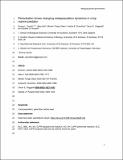Files in this item
Perturbation drives changing metapopulation dynamics in a top marine predator
Item metadata
| dc.contributor.author | Carroll, Emma L | |
| dc.contributor.author | Hall, Ailsa | |
| dc.contributor.author | Olsen, Morten Tange | |
| dc.contributor.author | Onoufriou, Aubrie B | |
| dc.contributor.author | Gaggiotti, Oscar E | |
| dc.contributor.author | Russell, Debbie J. F. | |
| dc.date.accessioned | 2020-07-27T16:30:01Z | |
| dc.date.available | 2020-07-27T16:30:01Z | |
| dc.date.issued | 2020-06-10 | |
| dc.identifier | 268489512 | |
| dc.identifier | 5d23fe2d-d240-4ab9-ac22-1138e3968fc6 | |
| dc.identifier | 32486973 | |
| dc.identifier | 85085908644 | |
| dc.identifier | 000541963000009 | |
| dc.identifier.citation | Carroll , E L , Hall , A , Olsen , M T , Onoufriou , A B , Gaggiotti , O E & Russell , D J F 2020 , ' Perturbation drives changing metapopulation dynamics in a top marine predator ' , Proceedings of the Royal Society of London Series B: Biological Sciences , vol. 287 , no. 1928 , 20200318 . https://doi.org/10.1098/rspb.2020.0318 | en |
| dc.identifier.issn | 0962-8452 | |
| dc.identifier.other | ORCID: /0000-0002-1969-102X/work/75609837 | |
| dc.identifier.other | ORCID: /0000-0002-7562-1771/work/75610086 | |
| dc.identifier.other | ORCID: /0000-0003-1827-1493/work/75610373 | |
| dc.identifier.other | ORCID: /0000-0002-4605-1896/work/75610521 | |
| dc.identifier.uri | https://hdl.handle.net/10023/20343 | |
| dc.description | Funding: O.E.G. was supported by the Marine Alliance for Science and Technology for Scotland, funded by the Scottish Funding Council (grant no. HR09011). E.L.C. was supported by a Newton Fellowship (Royal Society of London), Marie Curie Fellowship (EU Horizon2020) and a Rutherford Discovery Fellowship (Royal Society of New Zealand). A.J.H. and D.J.F.R. were supportedby NERC (grant no. SMRU 10/001). | en |
| dc.description.abstract | Metapopulation theory assumes a balance between local decays/extinctions and local growth/new colonisations. Here we investigate whether recent population declines across part of the UK harbour seal range represent normal metapopulation dynamics or are indicative of perturbations potentially threatening the metapopulation viability, using 20 years of population trends, location tracking data (n = 380), and UK-wide, multi-generational population genetic data (n = 269). First, we use microsatellite data to show that two genetic groups previously identified are distinct metapopulations: northern and southern. Then, we characterize the northern metapopulation dynamics in two different periods, before and after the start of regional declines (pre-/peri-perturbation). We identify source-sink dynamics across the northern metapopulation, with two putative source populations apparently supporting three likely sink populations, and a recent metapopulation-wide disruption of migration coincident with the perturbation. The northern metapopulation appears to be in decay, highlighting that changes in local populations can lead to radical alterations in the overall metapopulation's persistence and dynamics. | |
| dc.format.extent | 10 | |
| dc.format.extent | 246639 | |
| dc.language.iso | eng | |
| dc.relation.ispartof | Proceedings of the Royal Society of London Series B: Biological Sciences | en |
| dc.subject | Local population | en |
| dc.subject | Gene flow | en |
| dc.subject | Harbour seal | en |
| dc.subject | GC Oceanography | en |
| dc.subject | QH301 Biology | en |
| dc.subject | QH426 Genetics | en |
| dc.subject | DAS | en |
| dc.subject | SDG 14 - Life Below Water | en |
| dc.subject.lcc | GC | en |
| dc.subject.lcc | QH301 | en |
| dc.subject.lcc | QH426 | en |
| dc.title | Perturbation drives changing metapopulation dynamics in a top marine predator | en |
| dc.type | Journal article | en |
| dc.contributor.sponsor | The Royal Society | en |
| dc.contributor.sponsor | European Commission | en |
| dc.contributor.institution | University of St Andrews. School of Biology | en |
| dc.contributor.institution | University of St Andrews. Sea Mammal Research Unit | en |
| dc.contributor.institution | University of St Andrews. Scottish Oceans Institute | en |
| dc.contributor.institution | University of St Andrews. Marine Alliance for Science & Technology Scotland | en |
| dc.contributor.institution | University of St Andrews. Centre for Research into Ecological & Environmental Modelling | en |
| dc.identifier.doi | 10.1098/rspb.2020.0318 | |
| dc.description.status | Peer reviewed | en |
| dc.identifier.grantnumber | en | |
| dc.identifier.grantnumber | 656774 | en |
This item appears in the following Collection(s)
Items in the St Andrews Research Repository are protected by copyright, with all rights reserved, unless otherwise indicated.

